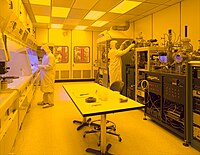
Photo from wikipedia
Abstract In this paper, a novel W-plate two-stage ESP was developed and investigated systematically through the experimental and simulated process. Numerical models and available calculation procedure of solving coupling electrostatic… Click to show full abstract
Abstract In this paper, a novel W-plate two-stage ESP was developed and investigated systematically through the experimental and simulated process. Numerical models and available calculation procedure of solving coupling electrostatic field, fluid field, and particle dynamics were established, whose accuracy was validated by experiments. The relationship among collection efficiency, gas velocity, and particle diameter was studied, and the distribution of electrostatic field, the evolution of EHD flow and fluid field, and particle dynamics, including particle charging, particle trajectory, transverse velocity, and particle concentration, were also investigated thoroughly. Results showed that W-plate two-stage ESP exhibited excellent number-based collection efficiency for fine particles which benefited from the reasonable structure design and the exceeding weak influence of EHD flow. Besides, the particle charging process suggested that the diameter decided the dominant charging mechanism, and the trajectory also played an important role in controlling the charging action. Compared with the behavior of each particle injected at different inlet positions, fine particles injected near the discharge wire got more charging number and quicker capture. Importantly, W-plate structure could exert its crucial role in capturing particles with the help of fluid field and inertial effect when inlet gas velocity increased rapidly. W-plate two-stage ESP had more than 90% number-based collection efficiency for >3 μm diameter particles and more than 75% number-based collection efficiency for 0.3–1 μm diameter submicron particles at 2 m/s gas velocity in both experimental and simulated investigations.
Journal Title: Advanced Powder Technology
Year Published: 2020
Link to full text (if available)
Share on Social Media: Sign Up to like & get
recommendations!